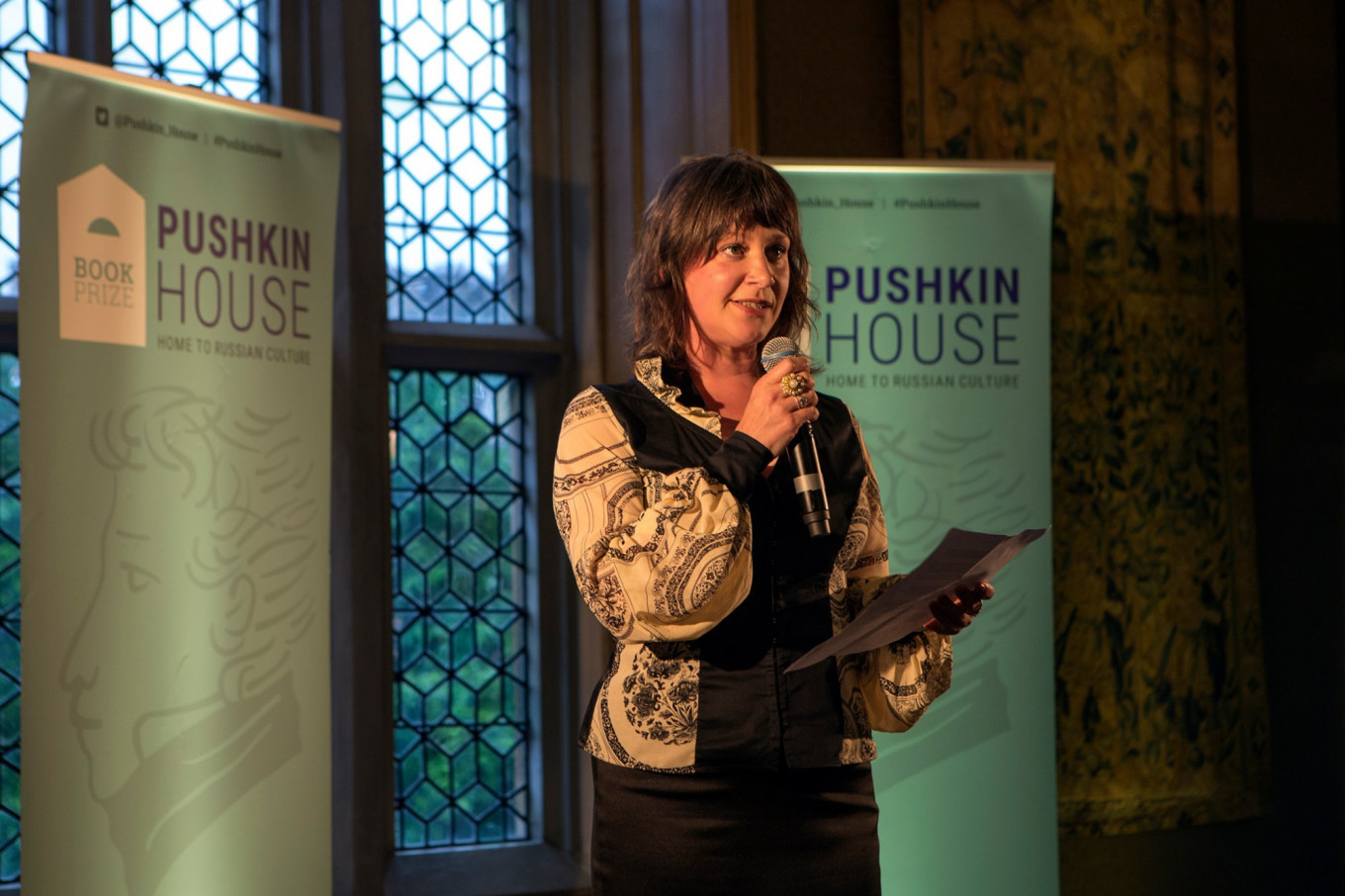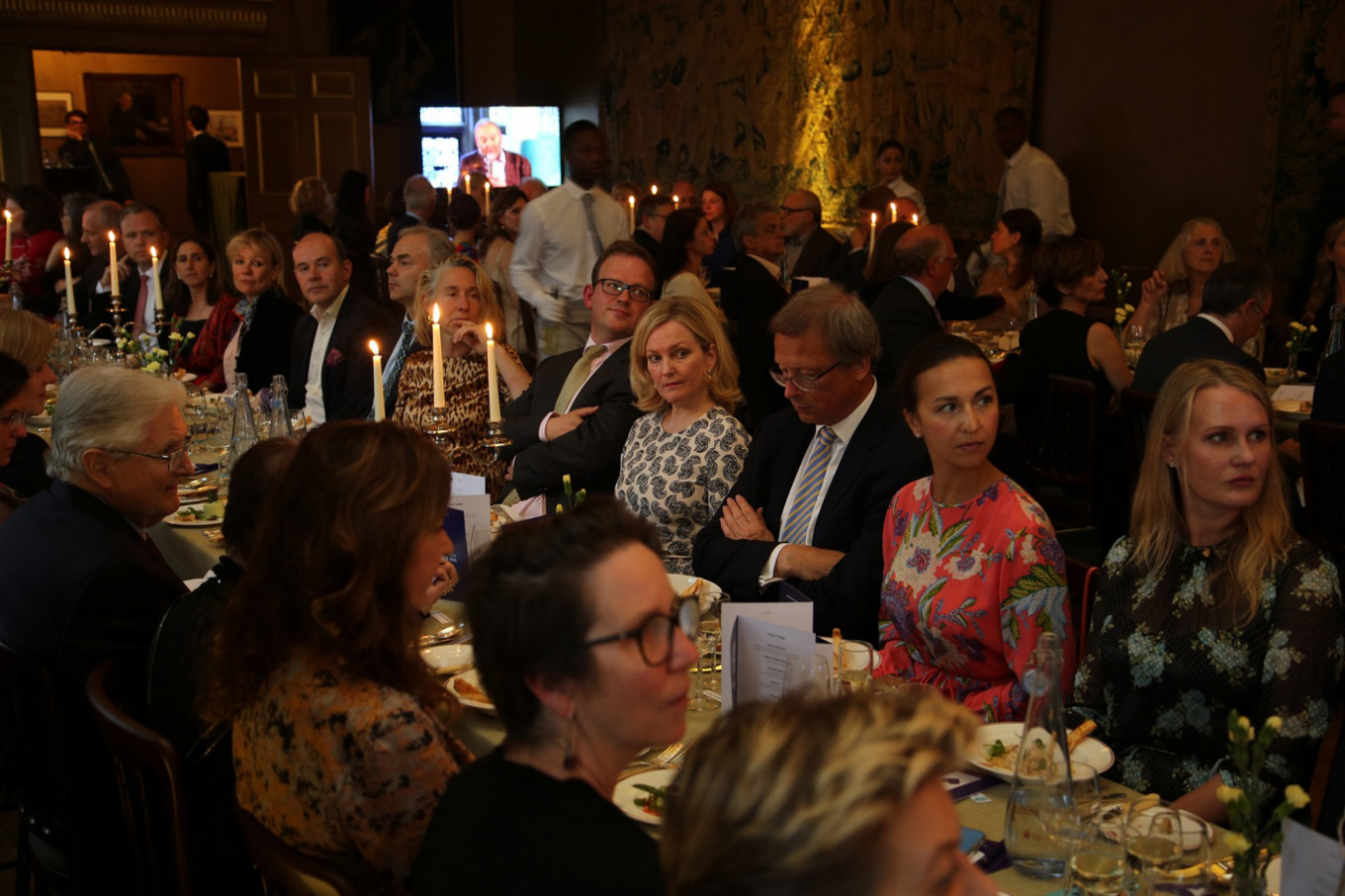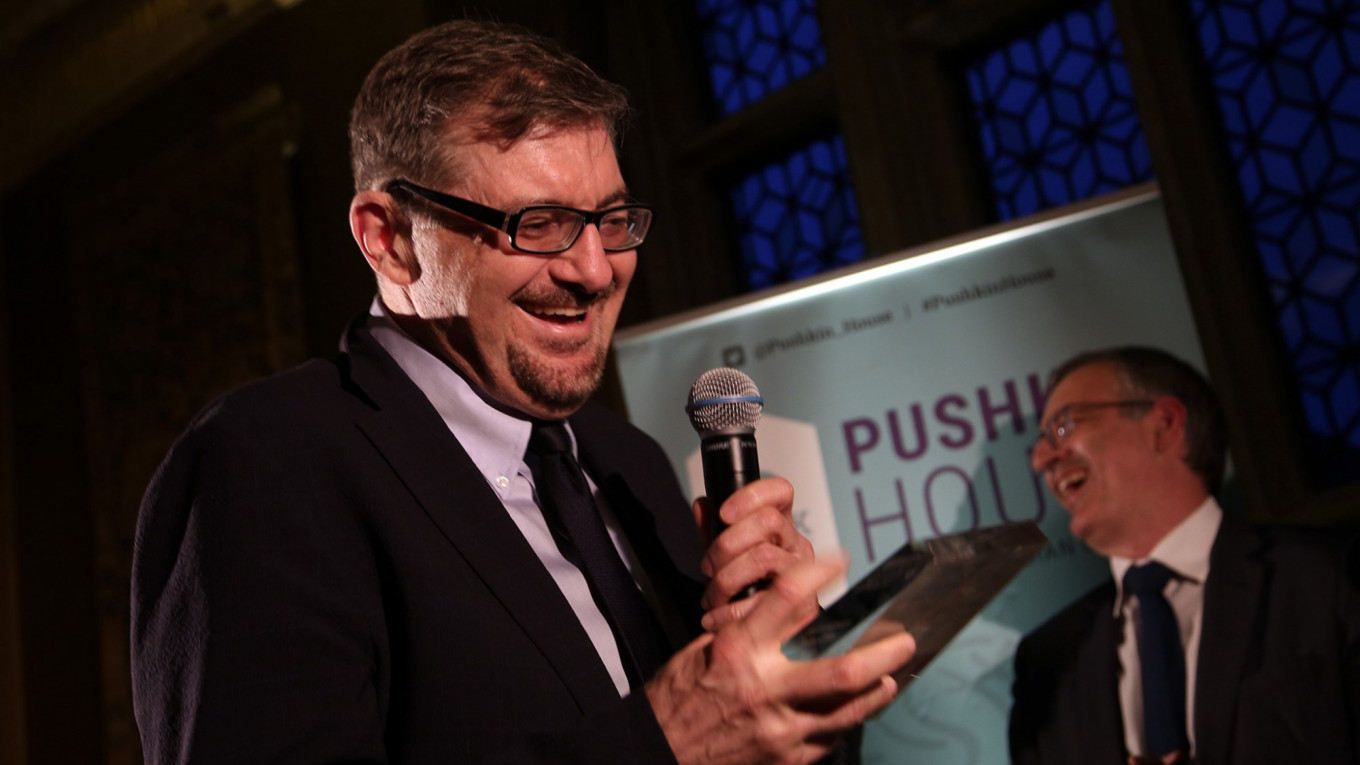This year’s winner of the Pushkin House Book Prize is Serhii Plokhy, whose book, “Chernobyl: History of a Tragedy” (Allen Lane) was announced at a ceremony in London on Wednesday. This was the second time Plokhy has won the award.
The Pushkin House Book Prize is unique in the world of literary competitions. First, it recognizes a very specific category of book: it must be non-fiction, about Russia, written in English (or translated into English from another language) and meant for a general, not academic, audience. Second, despite what might seem like a very narrow category of books, each year the shortlist highlights an impressive collection of genre-bending literature about Russia. And third, the books are judged by a particularly distinguished jury made up of bilingual scholars and specialists who live and work in both Russia and abroad. And finally, as the books are being read and judged by the jury members, Pushkin House organizes a plethora of podcasts, lectures, and talks dedicated to the nominees and their works, introducing them to an audience far beyond the walls of the organization.
This year, the seventh year the prize has been given, the members of the jury were Rachel Campbell-Johnston, chief art critic of The Times; Alexander Drozdov, executive director of the Yeltsin Presidential Center in Yekaterinburg; Alexis Peri, assistant professor at Boston University and winner of the 2018 Pushkin House Book Prize for “The War Within: Diaries from the Siege of Leningrad” (Harvard University Press); and Andrei Zorin , professor of Russian at Oxford University and a fellow of New College. The jury chair was Sergei Guriev, chief economist at the European Bank for Reconstruction and Development and professor of economics at Sciences Po Paris.

The jury winnowed down the original list of over 50 books to six nominees, all of which considered some aspect of post-war Russia. “Maybe Esther” by Katja Petrowskaja, translated from German by Shelley Frisch (4th Estate) is an innovative family memoir that traces, to the extent possible, her family across Europe. “To See Paris and Die: The Soviet Lives of Western Culture” by Eleonory Gilburd (Belknap Press at Harvard University Press) investigates how Western cultural artifacts exported to the Soviet Union during the Thaw period — from the death of Stalin in 1953 until the Soviet invasion of Czechoslovakia in 1968 — were transformed and acquired new meanings. “The Vory: Russia’s Super Mafia” by Mark Galeotti (Yale University Press) examines the rise of the criminal class and its influence on and integration into Russian society. In “The Spy and the Traitor” (Viking) Ben Macintyre tells the story of Oleg Gordievsky, a Soviet KGB officer who worked for MI6 in the U.K., combining a spy thriller with a history of the Cold War and agents of Soviet influence. Taylor Downing describes in terrifying detail how close the world came to nuclear annihilation in “1983: The World at The Brink” (Little, Brown). And Serhii Plokhy considers the Soviet Union three years later in “Chernobyl: History of a Tragedy” (Allen Lane).
Clementine Cecil, Pushkin House executive director, told The Moscow Times, “All the short listed authors produced stunning books — read together, you can put together a fairly comprehensive picture of life in the Soviet Union after the war, and in the events leading up to Perestroika. I would encourage readers to look at all of them.”
Sergei Guriev, chair of the jury, also noted the particularly high caliber of the books under consideration. “The jury has faced a challenging task of choosing the winner from a very impressive short list. Each book is an excellent read which promotes better understanding of both today’s Russia and of Russian and Soviet history. But,” he went on to say, “Chernobyl stands out as a well-researched and well-written masterpiece on an event of momentous importance. The Chernobyl disaster is not just a historical episode. The main themes discussed in the book strongly resonate today - and not just in Belarus, Russia, and Ukraine."
Cecil added that “It really is an extraordinary book — it has a narrative arc that manages to put the disaster in context like never before. Plokhy has an outstanding ability to home in on details and individuals, and their personal stories, and pull out again to show the reader the bigger picture. This is possible today, with new archival material, but also with more distance on the events of April 1986, but it needed a writer and historian or Plokhy's ability to pull it off.”
Plokhy, who is the only author to win the Book Prize twice, the first time for “The Last Empire” in 2015, told The Moscow Times, “I am very pleased and honored with the decision of the jury. Heraclitus is credited with the statement that one man can’t enter the same river twice. It looks like the jurors proved him wrong. On a more serious note, I hope the attention created with the prize will attract more attention to the book. It’s main theme, our relation as a society to nuclear energy, is as important today as it was back in 1986.”

The annual Pushkin House Book Prize of £5,000 is made possible thanks to contributions from Douglas Smith and Stephanie Ellis-Smith, The Polonsky Foundation and for the first time this year, the London Russian Book Club.
The Pushkin House, an independent charitable trust, was founded in 1954 as a venue for discussion, celebration, and preservation of Russian history and culture. It holds a wide variety of events, from concerts to lectures and art exhibitions, to support and enhance appreciation of Russian culture, and to encourage exchanges.
For more information about the book, the Pushkin House Book Prize, and other activities, see the organization's site.

From Part II: Inferno
Friday Night
In the control room are Leonid Toptunov, senior engineer; Aleksander Akimov, engineer; Razim Davletbaev, deputy head of the turbine unit; Anatolii Diatlov, deputy chief engineer; and Yurii Trehub, the shift leader. They don’t know it yet, but the disaster has already begun.
Toptunov, who had access to the computer data, shouted that the power level was rapidly rising. Diatlov later remembered that at the end of the test he heard the voices of Akimov and Toptunov. “I was about 10 meters away from them and did not hear what Toptunov said,” wrote a deputy chief engineer in his memoirs. “Sasha Akimov ordered a shutdown of the reactor and pointed with his finger— press the button.” The button that Akimov ordered Toptunov to press was AZ-5, the one used for SCRAM, or emergency shutdown of the reactor. Toptunov removed the paper cover from the button and pressed it. Diatlov and the rest of the crew in the control room could finally breathe a sigh of relief. The difficult test was over. The red AZ-5 button was supposed to do its job and shut down the reactor. It was an unusual measure, but this was an emergency.
Once the button was pressed, 178 control rods began to move in the active zone of the reactor. They were 7 meters long, moved at a speed of 40 centimeters per second, and were made of boron, which absorbed neutrons and reduced the rate of the reaction. The tips of the rods, however, were made of graphite, and the graphite tips appear to have tipped the already highly unstable reactor toward catastrophe. As the rods began to descend into the core of the reactor, the tips replaced neutron-absorbing water in the top part of the active zone, thus not decreasing, but further increasing, the rate of the reaction. This was the positive void effect—the deadly design problem of RBMK reactors that had almost destroyed one of them at the Leningrad power station in 1975. Now the positive void effect was once again at work.
The introduction of the control rods with their graphite tips caused a spike in the level of the reaction and a dramatic rise of the core’s temperature. The rise in temperature, in turn, caused the cladding of the fuel rods to fracture. These tubes, less than 14 millimeters, or approximately half an inch, in diameter, have zircaloy walls less than 1 millimeter, or 0.04 inches, thick, making them thinner than a strand of hair. The fractured fuel rods jammed the control rods, which by that time had been inserted to only one-third of their length. The core and the bottom of the reactor’s active zone remained out of reach of the rods, and the reaction there spun completely out of control. The power output of the reactor, which had hovered around 200 MWt, jumped to more than 500 MWt within a few seconds and then shot up to more than 30,000 MWt—ten times the norm. The rapidly increasing number of unabsorbed neutrons had burned away the xenon-135 that had been preventing the reactor from picking up speed a few minutes earlier. Now there was nothing to slow down the nuclear reaction. The fuel rods disintegrated, and the uranium fuel tablets in the zircaloy tubes of the fuel rods were released into the water of the cooling system, causing an enormous spike in the production of steam, which had nowhere to go.
Those in the control room heard a sudden roar. “That roar was of a completely unfamiliar kind, very low in tone, like a human moan,” remembered Razim Davletbaev. For Yurii Trehub, it was at first “as if a Volga [automobile] proceeding at full speed had started to brake and began to skid. It sounded like du-du-du-du.” Trehub then heard a roar like the one described by Davletbaev. After that came the shocks. “But not as in an earthquake,” remembered Trehub. “If you count[ed] ten seconds, there came a roar, and the frequency of the shocks diminished. But their strength increased. Then came the sound of the blast.” Those were the effects of the steam explosion that destroyed the casing of the reactor, throwing the concrete plate—the upper biological shield of the reactor that the operators called “Elena,” which weighed 200 tonnes—through the roof of Unit 4 and into the air. The plate, to which the entire infrastructure of the reactor was fastened, landed back on top of the reactor but did not cover it completely, leaving an opening through which it could freely “spit” radiation into the atmosphere. The time was 1:23:44.
Two seconds later, the operators heard another, much more powerful blast. “The floor and walls shook violently, dust and bits of debris fell from the ceiling, the luminescent lighting went off, semi-darkness descended, and only emergency lighting was on,” recalled Davletbaev. Those inside the control room heard and felt the explosions but did not know what had happened. An exploding reactor was the last thing on their minds. It was a difficult shift, and numerous alarms were going off, but such things had happened before.
If something was going wrong, it could only be the cooling system or the steam turbine, not the reactor. As far as they were concerned, the reactor and its panoply of safety systems were idiot-proof. No textbook they had ever read suggested that reactors could explode. “Everyone was in shock,” recalled Trehub, describing the scene after electricity was restored in the control room. “Everyone stood around with long faces. I was very frightened. Complete shock.”
They thought there had been an earthquake. It took them a while to realize that it was a man-made earthquake—one that they themselves had produced. The first blast was caused by the steam explosion as the excess steam produced by the breaking of the fuel channels escaped into the external cooling system, detonating it.
That explosion blew the Elena biological shield into the air, further damaging the fuel channels and tearing off the coolant lines attached to the shield. Without water to cool the active zone, the thermal power of the damaged reactor increased even more, causing a second, even more powerful explosion.
The second blast destroyed a good part of the containment building and threw graphite blocks into the air—the moderator core of the reactor, along with part of its fuel. The highly radioactive pieces of graphite landed on the roof of the neighboring Unit 3, and were scattered all over the land on which the power plant was built. The graphite also caught fire inside the damaged reactor, sending radioactive particles high into the sky.
The first to see what had happened were the scores of men who were fishing in the cooling pond of the power station on that warm April night—the pond that was used to breed fish and served as proof of the safety of the power plant. Two of the fishermen were very close to Unit 4, a mere 260 meters from the turbine hall. Suddenly they heard the dull sounds of the explosions, one and then the other. The ground shook under their feet, and the flames following the explosion suddenly illuminated the area, betraying their location. But no one came out to investigate. As fire rose higher and higher from the ruins of the reactor, they kept on fishing. They were hardly in a position to appreciate the significance of what they had witnessed: a nuclear star had fallen onto the earth, poisoning the land and water nearby, their catch, and the two fishermen themselves. They saw everything but realized nothing. They were the first but not the last to fail to grasp the reality.
Note: For ease of reading, the footnotes have been removed from this section.
Excerpted from “Chernobyl: History of a Tragedy”
Copyright © 2018 by Serhii Plokhy. Used by permission. All rights reserved.
A Message from The Moscow Times:
Dear readers,
We are facing unprecedented challenges. Russia's Prosecutor General's Office has designated The Moscow Times as an "undesirable" organization, criminalizing our work and putting our staff at risk of prosecution. This follows our earlier unjust labeling as a "foreign agent."
These actions are direct attempts to silence independent journalism in Russia. The authorities claim our work "discredits the decisions of the Russian leadership." We see things differently: we strive to provide accurate, unbiased reporting on Russia.
We, the journalists of The Moscow Times, refuse to be silenced. But to continue our work, we need your help.
Your support, no matter how small, makes a world of difference. If you can, please support us monthly starting from just $2. It's quick to set up, and every contribution makes a significant impact.
By supporting The Moscow Times, you're defending open, independent journalism in the face of repression. Thank you for standing with us.
Remind me later.







